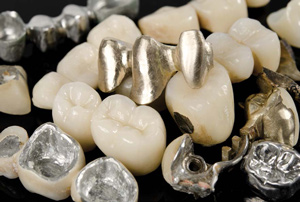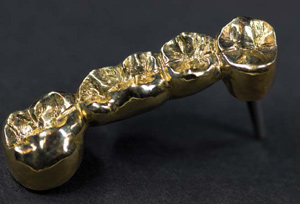Introduction
Dental alloys are alloys specially developed for the dental industry. They often contain precious metals like Gold, Silver, Platinum and Palladium. In the dental field, there are now far more than 1000 different alloys, with the precious metal alloys (high-gold, gold-reduced, palladium-based and silver-base alloys) in the majority. These elements form the basic material for the dental alloys used in amalgams, crowns, bridges and other dental fittings. Once removed, they are a valuable precious metals resource. Together, with other precious metal scrap (x-ray fixers and films, castings and their materials, trap filters, wipes,sweeps, and grindings from bench work), these products are processed by precious metal refiners. Compositional analysis is a critical part in the valuing and quality control of these materials. Not only is a visual test unreliable, but the weigh difference between karats may be negligible. |
In addition, analyzing dental gold by using conventional gold-purchase acids is difficult; the acid method which works for jewelry might not necessarily work for dental alloys, as they contain non-traditional alloying elements. The optimal analysis method for assaying dental alloys is X-Ray Fluoresence (XRF), a fast, precise, and nondestructive analytical technique. |
XRF AnalyzersPerformance You Can Count OnIn an economic environment where fast AND accurate results are more important than ever, the GoldXpert provides optimized precision and accuracy.
The GoldXpert is a crossover XRF analyzer, of offering benchtop analyzer performance and sensitivity with the convenience and mobility of a battery powered portable analyzer. The GoldXpert has an integrated PC, and only weighs 10 kg (22lbs). Its internally lit chamber allows sample viewing during tests, and offers an articulating sample holder for even the most unusually shaped pieces. |  |
The GoldXpert can be configured specifically for the measurement of precious metals in dental alloys. In addition to Au, Ag, Pt, and Pd the GoldXpert provides high level of performance of other elements like Ti, Cr, Mn, Fe, Ni, Cu, Zn, Ru, Rh, Zr, W, Ga, In, and others.
 |  |
Typical performance on dental alloys
| ASSAY | GoldXpert | Difference | ASSAY | GoldXpert | Difference | |
| Sample | Au % | Au % | Au -/+ | Pd % | Pd % | Pd +/- |
| 1 | 41.95 | 41.84 | 0.19 | 5.18 | 4.91 | 0.05 |
| 2 | 32.69 | 32.41 | 0.17 | 7.19 | 7.24 | 0.05 |
| 3 | 36.54 | 36.32 | 0.15 | 6.93 | 6.73 | 0.04 |
| 4 | 50.65 | 50.51 | 0.18 | 6.68 | 6.22 | 0.05 |
| 5 | 38.42 | 38.41 | 0.14 | 12.52 | 12.31 | 0.05 |
| 6 | 29.82 | 29.76 | 0.13 | 16.83 | 16.51 | 0.06 |
| 7 | 23.63 | 23.43 | 0.12 | 17.91 | 17.91 | 0.07 |
| GoldXpert | Basic Specifications |
| Weight | approximately 22 lb (10 kg) |
| Size | 267 x 350 x 330 mm closed chamber |
| Analysis chamber size | 125 x 210 x 180 mm with leaded glass viewing window and internal LED light |
| Source | 4W Au / Ta target X-ray Tube |
| Detector | Si-PIN (standard) /SDD (optional) |
| Calibration | Ti, V, Cr, Mn, Fe, Co, Ni, Cu, Zn, Ge, Zr, Nb, Mo, Ru, Rh, Pd, Ag, Cd, Sn, Sb, Hf, Ta, W, Re, Ir, Pt, Au, Pb, Bi, Ga, Se, In |
| (optional SDD instrument adds Os or other) | |
| Processor | 500 MHz Dual Core DSP, 530 MHz CPU |
| Power | AC power or Rechargeable Li-Ion Battery |
| Standard battery life is < 3 hours operation | |
| Display | 32 bit color QVGA display (high brightness touch-screen) 57 x 73 mm |
| Memory | Miscro SD 2GB memory (can store more than 150,00 data) |
| Communication | USB, Bluetooth |
| Sample Viewing | 3 mm small spot collimation for fine focusing (10 mm standard spot) |


